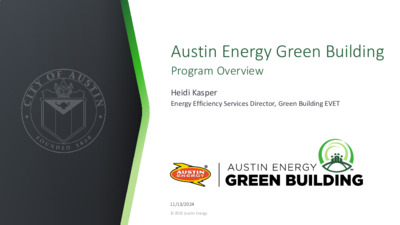Item 005 - Austin Energy Green Building Program Overview — original pdf
Backup

Austin Energy Green Building Program Overview Heidi Kasper Energy Efficiency Services Director, Green Building EVET 11/13/2024 © 2023 Austin Energy History and Mission Austin Energy Green Building developed the first rating system in the U.S. for evaluating the sustainability of buildings, creating a model for many other cities as well as the U.S. Green Building Council’s LEED certification system. Since 1991, Austin Energy Green Building has provided: • Ratings and programs • Education and outreach • Advocacy and planning Mission To cultivate innovation in building and transportation for the enrichment of the community’s environmental, economic and human well-being 2 Environmental and Community Impact Ratings AEGB provides design tools and rates the sustainability of new and remodeled Single Family, Multifamily and Commercial buildings. Education and Outreach AEGB creates education opportunities for the public and professionals plus celebrates rated projects through marketing and events. Policies and Codes AEGB uses program results to inform development of City of Austin codes, advance energy code and amend City development agreements. 3 Rating Goals and Measures Conservation Energy | Water | Materials Resource Generation Plan • • Water Forward Zero Waste Plan • Climate Equity Plan • Quality of Life Environment | Transportation | Education | Equity • • • • • Promote healthier indoor & outdoor environments Promote transportation options that work for everyone Increase human health & well-being Improve construction worker health and safety Provide buildings that work for everyone 4 Rating Structure The number of sustainability measures a project incorporates determines its star rating. Basic Requirements 30 – 54 pts 55 – 79 pts 80 – 104 pts 105 pts or more 1-Star 2-Star 3-Star 4-Star 5-Star 5 Austin Energy Green Building Ratings AEGB rates new construction and major renovation projects for three markets. Vaulted House Juno General Marshall Middle School Single Family Production and Custom Homes Multifamily Residential < 8 Stories Commercial and Residential > 7 Stories 20,927 17.3 K Austin | 3.7 K Extended Area 249 49.8 M sq. ft. | 43.6 K dwelling units 397 56.9 M sq. ft. | 15.9 K dwelling units 21,573 rated projects total reported from FY 1991 - 2024 6 AEGB Ratings Impact FY2007 – FY2024 By the Numbers Equivalent Impacts Demand savings – 429 MW Electricity savings – 936,181 MWh Natural Gas savings – 2,842,360 ccf Solar PV generation – 6,222 MWh CO2e savings – 176,532 metric tons Water savings – 1,250,543,000 gallons Construction Waste diversion – 2,014,794 tons Electricity use of 87,815 avg homes* Water use of 16,997 avg homes* Trash collection of 3,044,644 avg homes* CO2e reduced by 215,283 acres of U.S. forests in one year *average homes in Austin, Texas 7 Waste Management Impact AEGB helped create a market for construction waste diversion services. • Early 2000’s, there were few landfill alternatives other than construction waste used onsite as mulch or fill. • AEGB drove demand for services by requiring diversion of construction waste as a basic requirement for the commercial building rating. • AEGB helped contractors secure a City-owned site where construction waste could be sorted. • Construction waste diversion became widespread. In November 2015, the Austin City Council approved the Construction and Demolition Recycling Ordinance. FY2007 – FY2024 Construction Waste Diverted from Landfill 2.01 M tons 8